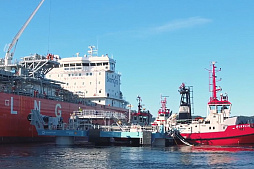After receiving the necessary documents and project presentation, our team will try to review your request as soon as possible, and leading experts will offer the best options for project funding.
This requires a multi-billion investments that will pay off in decades and must be backed by appropriate contractual structures and financial models.
Modern seaports today carry out diverse activities that include but are not limited to the following:
• The main activity is transshipment of commercial cargo in ports and terminals.
• Ancillary activities providing maritime transport: shipping, pilotage services, salvage, dredging and underwater work, ship towing and other maritime services.
• Activities of various maritime transport agencies, including customs, brokerage, maritime consulting, forwarding, cargo stowage and securing, cargo control and more.
Given the growing complexity of shipping and seaport services, experts draw attention to the importance of a comprehensive approach to the development of seaports and terminals, including their construction and modernization.
The key role in the industry belongs to the correct choice of the financial model of the seaport, which creates an economic foundation for the successful implementation of a multi-million dollar investment project.
GCAM Investment Group has brought under one roof a team of motivated professionals from the fields of finance, investment and engineering to provide comprehensive support for large projects around the world, including the construction of commercial seaports and freight terminals.
If you need long-term project financing or consulting services, please contact us at any time.
Development of financial models for seaports and freight terminals
Financial modeling should focus on the key elements of qualitative and quantitative financial analysis in order to support investment decisions and the choice of financing scheme.Using the correct inputs and analyzes, the project team should develop a comprehensive financial model to evaluate a specific project and select the financial option that is of greatest interest to its owners.
The financial model of the seaport (terminal) should be clearly structured to assess the financial impact of various elements, as well as determine the optimal financial structure using risk analysis.
A detailed analysis of existing loan instruments allows the project team to achieve the following:
• Determine the optimal parameters for debt financing of a particular project.
• Determine the need for capital and the level of risk that partners can accept.
• Draw conclusions about the viability of the project in one form or another.
Financial models should be based on spreadsheets and include flexible digital tools that allow the project team to change the initial parameters of the project and evaluate their impact on the result.
The financial model of the seaport project should be deeply integrated with the cash flow model. The seaport model should include all projected revenues, operating expenses and debt servicing. It should take into account incremental revenues, O&M costs, and other project-related costs.
While concession solutions and other innovative approaches to seaport financing may look attractive, owners should beware of potential restrictions and risks to their current financial health.
High quality pre-project analysis can help identify project risks so that port owners can adjust their strategy and investment decisions accordingly.

Basic approaches to creating a financial model
The development of a financial plan requires a review of the financial situation and the adoption of strategic decisions related to debt management and infrastructure development.Critical to this task is an understanding of the project financing structure, including the debt structure and changing financial needs as the port project develops.
The traditional approach to creating a financial plan and a financial model for a seaport is based on key project indicators.
The preliminary list of key indicators includes the following:
• Evaluation and forecasting of the credit rating.
• Alternative financing options, including budget financing, lending, etc.
• Selection of the optimal contract model for construction, financing and operation.
• Debt parameters, including the possibility of its restructuring.
• Choosing a long-term investment strategy for the company.
• Modeling of cash flows, including projected revenues and their sources, estimated maintenance and operation costs, as well as the possible issuance of debt securities.
• Analysis of asset and liability management, including the potential use of short-term / medium-term floating rate financing instruments.
In the case of project finance, it is necessary to develop long-term investment models for a period of 25-30 years or more in order to ensure the implementation of all plans for the development of the seaport, its terminals and transport infrastructure.
The financial model is used as the main tool for finding alternatives, taking into account the existing limitations of the financial market.
The result of financial modeling should be a set of comprehensive recommendations that would provide a basis for effective financial management of the seaport project and satisfy all its needs.
Recommendations should be consistent with the overall strategy of the participating companies. Financial plans supported by high-quality models are often used to improve credit scores and to support applications for grants or loans.
It is important to understand the credit profile of various programs and projects, and to tailor the financial plan to the specific needs of the seaport.
Project finance in the construction of seaports
Given the enormous cost of engineering, building, modernizing and operating modern seaports, traditional corporate finance tools in this area are increasingly giving way to alternative off-balance sheet financing schemes based on project finance.In these innovative schemes, the borrower is a formally independent Special Purpose Vehicle (SPV).
The funds are provided against the cash flows of the project. Essentially, this seaport financing model is driven by the viability of the project, its ability to generate sufficient revenue in the future to service the debt and satisfy all stakeholders.
Key features of project finance include the following:
• Suitability for large investment projects in the real economy, which are subject to strict requirements in terms of reliability and financial stability.
• Complex contract structure and high requirements for the financial and technical documentation, which must be supported by numerous studies.
• Formal separation of the investment project from the assets of the initiating companies, allowing creditors to rely only on the effectiveness of the project itself.
• Wide use of the entire range of instruments for financing investment projects, including innovative financial instruments.
• Establishment of an independent company that will act as a borrower and use the future profits of the project to pay off debt.
• Investment risk in project finance is distributed among different entities, taking into account their ability to control certain types of risks.

Creating a financial model of a seaport begins with obtaining and analyzing project input data and performing a series of calculations relating to various methods of raising capital, as well as various project contract structures.
The implementation of such investment projects on the basis of project finance (PF) provides participants with numerous benefits, including the following:
• Use of multiple funding sources, including complex schemes.
• Effect of financial leverage required for capital-intensive projects.
• Protecting the ownership structure of participants from project failure.
• Lack of collateral for loans due to financing against future cash flows.
• Optimal risk distribution scheme between participants.
Building a high-quality financial model allows participants to use various project financing options, including changes in the structure and sources of financing, the use of various debt instruments, etc.
Project teams can use different funding approaches to increase the success rate of a seaport investment project.
Possible sources of financing include, but are not limited to, various forms of public-private partnership financing, leasing instruments, loans from special infrastructure banks (for example, SIB loans in the USA), mezzanine financial instruments, and so on.
The use of such tools should be coordinated through close communication with stakeholders and decision makers to ensure that all issues are properly addressed.
In any case, the goal of financial modeling of a seaport project is to create a sustainable financial plan that minimizes the share of public funding and allows the necessary private capital to be attracted on adequate terms.
Analyzing and structuring various project finance methods allows participants to develop multiple financial models to assess the viability of a recommended seaport project.
Regardless of the type of model, it should accurately represent the complex financing structures that can provide alternatives to traditional financing methods, including deeply subordinated debt schemes.






















